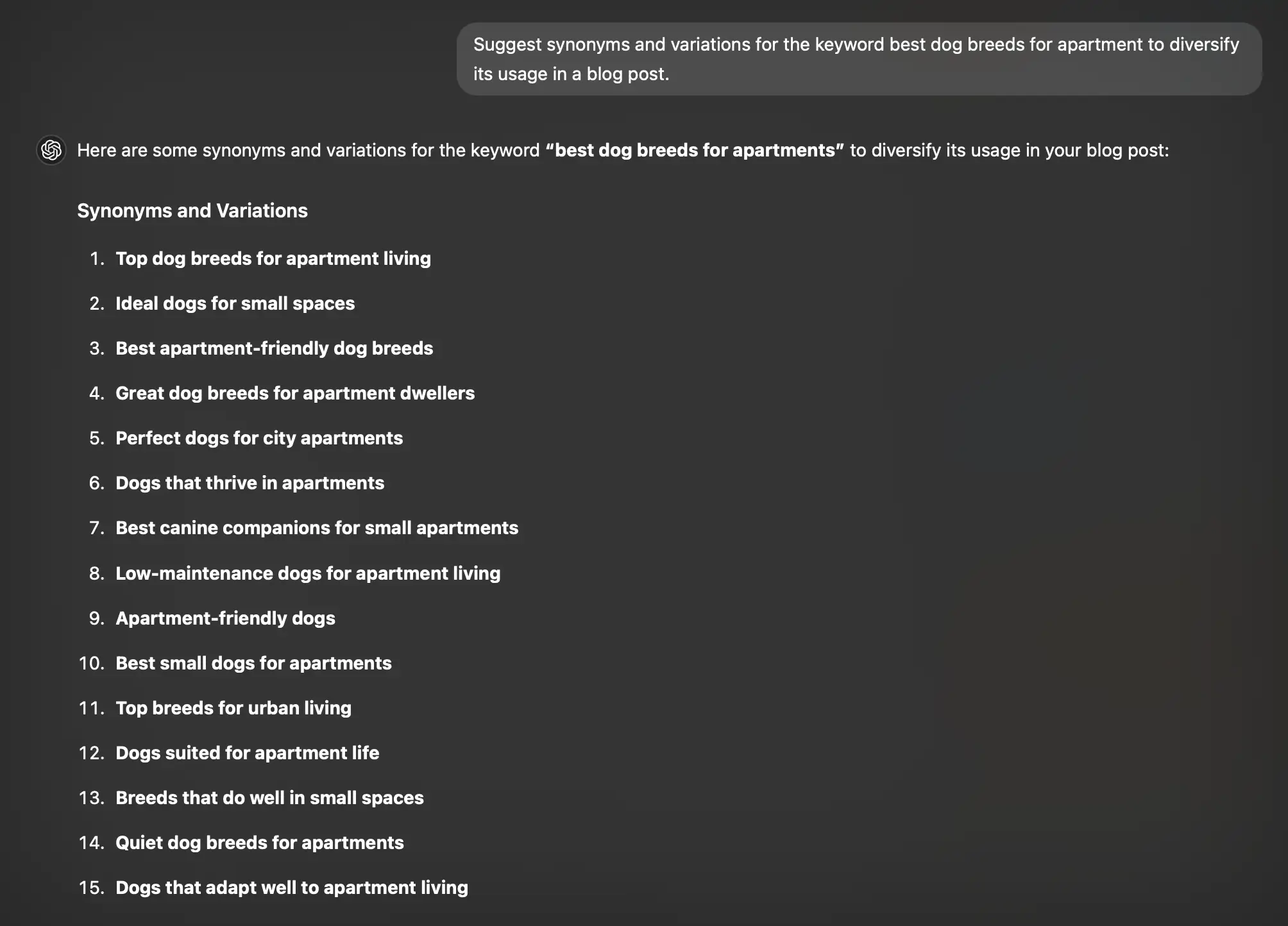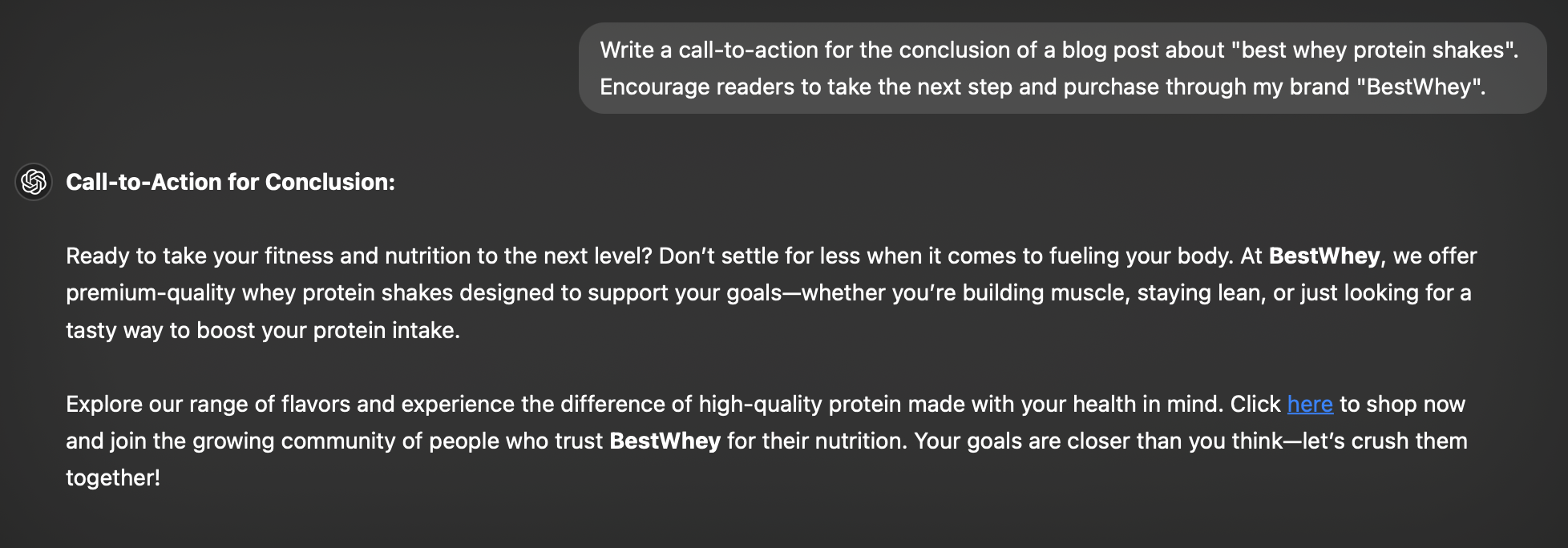ChatGPT Prompts for Writing Blog Posts in 2025: Doing It the Right Way
Writing a compelling blog post has never been easier—or harder.
While tools like ChatGPT offer incredible potential to streamline your writing process, it’s easy to misuse them.
How many times have you seen content that’s generic, overly robotic, or misaligned with its audience? It’s not the tool’s fault; it’s all about how you use it.
If you’re looking to craft blog posts that truly stand out, this guide is for you. With the right ChatGPT prompts for writing blog posts, you’ll learn how to maximize this AI tool’s capabilities, from brainstorming ideas to refining your final draft.
Let’s dive into the do’s, don’ts, and best practices for using ChatGPT for writing blog posts the right way.
Step 1 (REALLY IMPORTANT!): Starting with Strong Prompts
A good blog post begins with a great idea, but transforming that idea into impactful content depends on the quality of your prompt.
Crafting a strong prompt ensures that ChatGPT understands your needs and delivers precise, engaging output. Here are expanded strategies to help you master this first step.
ChatGPT Prompts for blog posts: Generating Blog Ideas
ChatGPT Prompt
Suggest five blog post ideas for [specific niche], targeting [specific audience], and focusing on [goal, e.g., increasing engagement or driving conversions].
Example: For a technology blog targeting small business owners, ChatGPT might generate:
- “Top 10 Affordable Tech Tools for Small Businesses in 2025”
- “How AI is Changing Small Business Operations”
- “5 Cybersecurity Tips Every Entrepreneur Should Know”
- “The Best CRM Software for Growing Startups”
- “How to Automate Your Workflow Using Free Tools”
Use these ideas as a foundation, and ask ChatGPT follow-up questions like, “Expand on the third idea and outline key sections for the post”. This helps refine your approach and tailor content to your audience.
ChatGPT Prompts for blog posts: Exploring Trending Topics
ChatGPT Prompt
What are the top trending topics in [specific industry] for 2025? Include examples of why these topics are relevant and how they can attract readers.
Example: For the fitness industry:
- “The Rise of Hybrid Workouts: Mixing At-Home and Gym Routines”
- “How Wearable Tech is Revolutionizing Fitness”
- “Sustainability in Activewear: A Growing Movement”
These trending topics ensure your blog post aligns with current interests. As always, you can keep asking ChatGPT to expand and go even deeper on each one of these topics.
ChatGPT Prompts for blog posts: Refining Your Target Audience
ChatGPT Prompt
Help me identify my target audience for a blog about [specific topic]. Include their demographics, interests, and common challenges.
Example: For a parenting blog about homeschooling:
- Demographics: Parents aged 30-45 with children aged 6-12.
- Interests: Creative teaching methods, curriculum recommendations, and work-life balance strategies.
- Challenges: Lack of time, difficulty sourcing materials, and maintaining children’s focus.
With a clear understanding of your audience, you can tailor your content to meet their specific needs, making it more impactful.
Step 2: Structuring Your Blog Content
Even the most compelling topic can lose its impact without a clear structure.
A well-organized blog post keeps readers engaged and ensures your message is delivered effectively. ChatGPT can assist with every aspect of structuring your content, especially for those most challenging topics.
ChatGPT Prompts for blog posts: Asking To Create An Outline
ChatGPT Prompt
Draft a detailed outline for a blog post about [specific topic], including an introduction, main sections, and a conclusion.
Example:

This outline ensures your content flows logically, covering all key points without thinking about everything you want to cover when creating your blog post.
ChatGPT Prompts for blog posts: Refining Headings and Subheadings
ChatGPT Prompt
Rewrite these headings to make them more engaging and SEO-friendly: [list of headings].
Example:
Original: “Time Management Techniques for Remote Workers”
Improved: “Master Time Management: Top Strategies for Remote Workers”
Strong, engaging headings help grab attention and boost your post’s visibility in search engine results.
Step 3 (BEST for Google): Enhancing SEO and Google Rankings
A blog post is only as good as its ability to reach the right audience.
By leveraging ChatGPT prompts for writing blog posts, you can seamlessly integrate SEO and maintain an engaging tone that resonates with readers.
This can ensure your content ranks well while maintaining that human touch and reader-friendly approach.
ChatGPT Prompts for blog posts: SEO Optimization
ChatGPT Prompt
Rewrite this [paragraph, draft, post] to include the SEO keyword [SEO keyword] naturally and improve its readability
This prompt helps you balance keyword integration with clarity, ensuring your blog appeals to both readers and search engines.
It can also give you ideas on how to add the keyword you’re targeting into your content without sounding too pushy.
ChatGPT Prompts for blog posts: Finding Synonyms and Keyword Variations
ChatGPT Prompt
Suggest synonyms and variations for the keyword [enter keyword here] to diversify its usage in a blog post.
Example:

Using variations prevents keyword stuffing while maintaining relevance, improving your post’s SEO performance and how it’s ranked and perceived by Google.
Step 4 (Making it human): Adding Value Through Examples and Data
The most engaging and human-friendly blog posts are those that provide actionable insights, backed by examples and data.
ChatGPT can help you enrich your content with relevant case studies, relatable scenarios, and credible statistics, making your blog post stand out.
Make sure to always validate the data that ChatGPT shares, as it sometimes can make mistakes.
ChatGPT Prompts for blog posts: Generating Real-Life Examples
ChatGPT Prompt
Provide a real-life example of how [specific tool or strategy] has helped [specific audience] achieve [specific outcome].
Example: “Jane, a freelance writer, struggled to manage her workload. By using ChatGPT prompts for writing blog posts, she created a content calendar in minutes, saving her over five hours a week.”
Real-life examples make your content relatable and build trust with your audience by showing practical applications.
ChatGPT Prompts for blog posts: Incorporating Relevant Data and Statistics
ChatGPT Prompt
Find three recent statistics related to [specific topic] and suggest how to incorporate them into a blog post.
Example: For a blog on remote work:
- “85% of remote workers say they’re more productive working from home.” (Source: XYZ Study)
- “Companies save an average of $11,000 per year per remote employee.” (Source: ABC Report)
Including data supports your arguments and enhances the credibility of your blog post, making it more persuasive.
ChatGPT Prompts for blog posts: Writing Case Study Highlights
ChatGPT Prompt
Summarize this case study: [insert case study text]. Highlight the problem, solution, and outcome.
Example: “A small marketing agency struggled with time-consuming content creation. By integrating ChatGPT into their workflow, they reduced content production time by 40% and saw a 20% increase in client satisfaction.”
Summarized case studies add depth to your blog, showing how your advice has worked in real scenarios.
Step 5: Refining Your Blog posts Drafts
After generating content with ChatGPT, refining your draft is crucial to ensure clarity, engagement, and professionalism.
Editing is where your blog post evolves from good to great. Here are three prompts to help you polish your blog posts.
ChatGPT Prompts for blog posts: Making blog posts clearer and easier to read
ChatGPT Prompt
Edit this paragraph to make it clearer and easier to read as if a human was writing it: [insert paragraph].
Example:
Original: “Time management is important because it helps you complete tasks and stay on schedule, which ultimately leads to increased productivity and less stress.”
Revised: “Effective time management helps you stay on schedule, boost productivity, and reduce stress.”
ChatGPT Prompts for blog posts: Checking for Consistent Tone
ChatGPT Prompt
Review this blog post and suggest edits to ensure a consistent tone throughout. The tone should be friendly and informative.
A consistent tone builds credibility and can maintain your readers’ trust from start to finish. You can even use other blog posts as example and ask ChatGPT to follow the same tone/language of your example.
ChatGPT Prompts for blog posts: Creating Call-to-Actions
If you suck at writing call-to-actions, just like I do, ChatGPT can certainly help you with that. A strong call-to-action drives engagement and helps achieve your blog’s goals, whether it’s building community or generating leads.
ChatGPT Prompt
Write a call-to-action for the conclusion of a blog post about [specific topic]. Encourage readers to take the next step.
Example:

What Not to Do: Rookie Mistakes to Avoid
While ChatGPT can be an incredibly powerful tool for blog writing, improper use can lead to generic or ineffective content.
Recognizing common pitfalls is essential to ensure you maximize its potential while avoiding mistakes that undermine your efforts.
Here are three common issues to avoid, along with prompts to help you steer clear of them.
Avoid Vague Prompts
ChatGPT Prompt
Rewrite this vague prompt to make it more specific: ‘Write about productivity.’ Provide an example of a better version.
Example:
Original Prompt: “Write about productivity.”
Improved Prompt: “Write a blog post about three productivity techniques for remote workers, including how to implement each one effectively.”
Specific prompts ensure that ChatGPT provides focused and relevant output, saving you time on editing and revisions.
Balance AI and Human Voice
ChatGPT Prompt
How can I ensure my blog post doesn’t sound overly robotic? Suggest edits to make the tone more conversational and human.
Example:
Original: “Utilizing these tools will maximize efficiency in workplace environments.”
Revised: “These tools can help you work smarter, not harder, and make your day-to-day tasks much easier.”
This will ensure your blog feels human and authentic, which is key to building trust with your audience and, especially with SERP tools like Google.
Avoid Keyword Stuffing
ChatGPT Prompt
Rewrite this paragraph to include the keyword [enter keyword here] naturally without overusing it.
Example:
Original: “ChatGPT prompts for writing blog posts make content creation easier. ChatGPT prompts for writing blog posts help with SEO.”
Revised: “Using ChatGPT prompts for writing blog posts simplifies content creation and ensures your posts are optimized for SEO without extra effort.”
This helps maintain readability while keeping your blog post SEO-friendly.
Before you leave…
With the right ChatGPT prompts for writing blog posts, you can create engaging, SEO-optimized content that resonates with your audience.
Start with clear and specific prompts, focus on adding value through examples and storytelling, and refine your drafts for maximum impact.
Remember, it’s not just about using AI—it’s about using it the right way. For more tips,check out our blog.






